|
WORK OF THE COUNTRY AND MARINE PARKS BRANCH
- To conserve the natural environment through the identification, designation and management of suitable areas as country parks, special areas, geopark, marine parks and marine reserves;
- To conserve important marine and terrestrial fauna and flora, such as the Chinese white dolphins, finless porpoises, coral communities, birds, mammals, butterflies and dragonflies;
- To promote nature appreciation through publicity and educational activities and the provision of suitable facilities.
COUNTRY AND MARINE PARKS
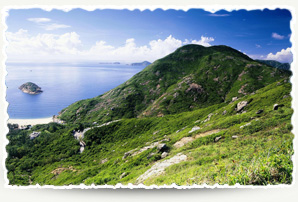 To conserve the countryside, by March 2012, 44,239 hectares (about 40 % of Hong Kong's total land area) had been designated as country parks and special areas. The Department manages all 24 country parks and 22 special areas for conservation, recreation, education and tourism. Hiking trails, mountain bike trails, nature trails, barbecue and picnic sites, camp sites and visitor centres are provided in the country parks, drawing some 13.3 million visitors in 2011-12. To conserve the countryside, by March 2012, 44,239 hectares (about 40 % of Hong Kong's total land area) had been designated as country parks and special areas. The Department manages all 24 country parks and 22 special areas for conservation, recreation, education and tourism. Hiking trails, mountain bike trails, nature trails, barbecue and picnic sites, camp sites and visitor centres are provided in the country parks, drawing some 13.3 million visitors in 2011-12.
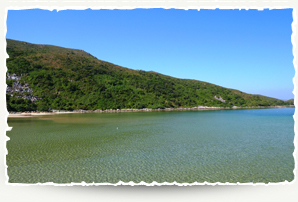 The Department manages four marine parks and one marine reserve for conservation, recreation, education and scientific studies, covering 2,430 hectares. They comprise scenic coastal areas, seascapes and important marine habitats with an abundance of important marine fauna and flora, providing ideal opportunities for diving, snorkelling, canoeing and underwater photography. Some 211,400 visitors to marine parks were recorded in 2011-12. The Department manages four marine parks and one marine reserve for conservation, recreation, education and scientific studies, covering 2,430 hectares. They comprise scenic coastal areas, seascapes and important marine habitats with an abundance of important marine fauna and flora, providing ideal opportunities for diving, snorkelling, canoeing and underwater photography. Some 211,400 visitors to marine parks were recorded in 2011-12.
A map showing the country parks, special areas, marine parks, marine reserve and the Hong Kong Global Geopark of China is at Appendix 13.
HILL FIRES
In 2011-12, 16 hill fires occurred over an area of 27 hectares with 580 trees damaged in country parks. With relatively humid weather during the year, the number of hill fires and vegetated area affected were much reduced as compared with the previous years. Rehabilitation planting programme in areas damaged by hill fires and various fire prevention measures have been implemented.
TREE PLANTING
Some 740,000 seedlings were planted in 2011-12. To enrich local plant diversity, the Department continued to produce and plant seedlings of native tree species. Major native species planted included Castanopsis (Castanopsis fissa), Chinese Hackberry (Celtis sinensis), Gordonia (Gordonia axillaris), Sweet Gum (Liquidambar formosana), Zhejiang Machilus (Machilus chekiangensis), Many-nerved Machilus (Machilus pauhoi) and Chinese Gugertree (Schima superba). Among all seedlings planted, 70% were native species. the Department continued to produce and plant seedlings of native tree species. Major native species planted included Castanopsis (Castanopsis fissa), Chinese Hackberry (Celtis sinensis), Gordonia (Gordonia axillaris), Sweet Gum (Liquidambar formosana), Zhejiang Machilus (Machilus chekiangensis), Many-nerved Machilus (Machilus pauhoi) and Chinese Gugertree (Schima superba). Among all seedlings planted, 70% were native species.
Seedlings are produced in Tai Tong Nursery for tree planting in country parks. Located in Tai Lam Country Park with an area of 9.5 hectares, the nursery produces over 650,000 seedlings of more than 100 species annually.
COUNTRY PARK PLANTATION ENRICHMENT SCHEME
In the early years, exotic pioneer species such as Taiwan Acacia (Acacia confusa), Brisbane Box (Lophostemon confertus) and Slash Pine (Pinus elliottii) were planted to prevent soil erosion and to quickly restore vegetation cover. This objective has been achieved with sustained efforts in the last few decades.
With time, existing plantations in country parks are facing problems such as aging, withering and overgrowing. Trees species found within the plantations are relatively uniform comprising mainly exotic species, making it difficult for them to fully satisfy the needs of native wildlife for food and shelters, thus unattractive to local wildlife. In addition, many trees aged simultaneously in the plantations, hindering the sustainable development of the woodland habitats. The dense canopies of the trees could have affected the natural propagation of native trees. The landscape and ecological value of these plantations would need to be enhanced. The Department launched the Country Park Plantation Enrichment Scheme (the Scheme) at the end of 2009 to enrich the overall value of country park plantations. The objectives of the Scheme are as follows:
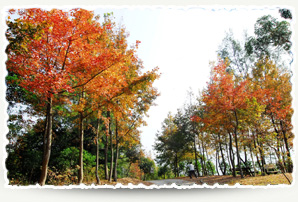 (i) To improve the ecological habitat of the plantation areas;
(i) To improve the ecological habitat of the plantation areas;
(ii) To increase the biodiversity of both local flora and fauna;
(iii) To allow healthy growth and sustainable development of the
woodlands;
(iv) To provide seeds of native trees;
(v) To enhance the landscape of the country park plantation
areas; and
(vi) To reduce the chance of pest outbreaks.
During the dry season of 2011, 14 sites were engaged under the Scheme and about 3,500 exotic trees in poor conditions were removed. Suitable native tree seedlings were in-planted in the plantation areas in the following planting season of 2011. It is expected that the newly planted seedlings would gradually establish in the thinned woodland, and eventually replacing all the exotic species. The Department will continue to carry out the Scheme in the coming years to improve all plantations in country parks systematically to enhance the overall ecological value of the country parks.
TREE MANAGEMENT
To improve tree management in Hong Kong for the sake of public safety, the Department stepped up efforts on tree inspection, risk assessment and tree maintenance at the recreation sites of country parks and the areas adjacent to non-expressway public roads. Over 28,000 trees (involving about 1,620 sites and 280 tree groups adjacent to public roads) and 5 Old and Valuable Trees have been inspected. Tree management measures such as pruning and thinning, were prescribed for trees in poor health conditions or with high potential danger to the public. Tree management work was carried out by qualified and experienced in-house staff.
MOUNTAIN BIKE ACTIVITIES
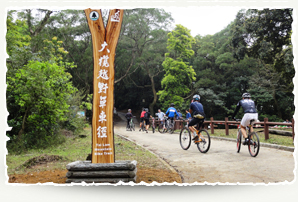 To cope with the increasing popularity of mountain biking activities in country parks, two new mountain bike trails, i.e. the Tai Lam Mountain Bike Practice Loop and the Tin Fu Tsai North Section Mountain Bike Trail, were built and opened to the public during the year. The Tai Lam Mountain Bike Practice Loop is located near Twisk Management Centre in Tai Lam Country Park. It consists of a 200-metre loop designed for beginners and a 200-metre section for mountain bikers with intermediate skill level. The Tin Fu Tsai North Section Mountain Bike Trail, also located in Tai Lam Country Park, is 2.1 km long, forming a loop near the Tin Fu Tsai Fire Lookout. About two-third of this trail is made of natural soil surface and the rest is forest track with concrete surface. To cope with the increasing popularity of mountain biking activities in country parks, two new mountain bike trails, i.e. the Tai Lam Mountain Bike Practice Loop and the Tin Fu Tsai North Section Mountain Bike Trail, were built and opened to the public during the year. The Tai Lam Mountain Bike Practice Loop is located near Twisk Management Centre in Tai Lam Country Park. It consists of a 200-metre loop designed for beginners and a 200-metre section for mountain bikers with intermediate skill level. The Tin Fu Tsai North Section Mountain Bike Trail, also located in Tai Lam Country Park, is 2.1 km long, forming a loop near the Tin Fu Tsai Fire Lookout. About two-third of this trail is made of natural soil surface and the rest is forest track with concrete surface.
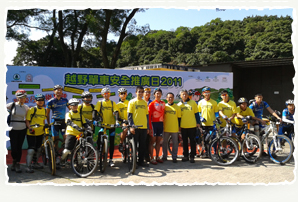 The trail is suitable for cyclists with a certain amount of mountain biking skills. A picnic site near the trailhead of Tin Fu Tsai North Section Mountain Bike Trail was also converted to a mountain bike training ground, which provides a number of features for mountain bikers to develop their skills. Both new trails are designed and built in accordance with the principles for sustainable trail promoted by the International Mountain Bicycling Association of USA. Furthermore, an event "Share the Trail, Share the Fun" was jointly held by the Department and Hong Kong Cycling Association in Tai Lam Country Park on December 4, 2011 to promote mountain biking safety and the share use of mountain bike trails in country parks. The trail is suitable for cyclists with a certain amount of mountain biking skills. A picnic site near the trailhead of Tin Fu Tsai North Section Mountain Bike Trail was also converted to a mountain bike training ground, which provides a number of features for mountain bikers to develop their skills. Both new trails are designed and built in accordance with the principles for sustainable trail promoted by the International Mountain Bicycling Association of USA. Furthermore, an event "Share the Trail, Share the Fun" was jointly held by the Department and Hong Kong Cycling Association in Tai Lam Country Park on December 4, 2011 to promote mountain biking safety and the share use of mountain bike trails in country parks.
HONG KONG GLOBAL GEOPARK OF CHINA
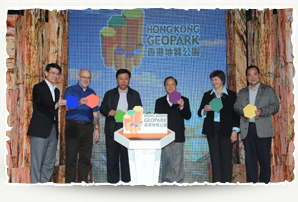 A geopark is a unique natural area with special geological significance, as well as natural and cultural landscapes, serving the objectives of conservation, education and sustainable development. Hong Kong Geopark was opened in 2009 and acquired global status in 2011 to protect Hong Kong’s rich geological resources and their high research, tourism, educational and scenic value. A geopark is a unique natural area with special geological significance, as well as natural and cultural landscapes, serving the objectives of conservation, education and sustainable development. Hong Kong Geopark was opened in 2009 and acquired global status in 2011 to protect Hong Kong’s rich geological resources and their high research, tourism, educational and scenic value.
The United Nations Educational, Scientific and Cultural Organisation (UNESCO) announced its acceptance of Hong Kong National Geopark as a member of the Global Geoparks Network (GGN) at the 10th European Geoparks Conference in Langesund, Norway on September 17, 2011. Subsequent to becoming a member of the GGN, Hong Kong National Geopark was officially renamed Hong Kong Global Geopark of China.
An opening ceremony was held at the Hong Kong Cultural Centre on December 14, 2011. Guests included officials from the Hong Kong and Macao Affairs Office of the State Council and the Ministry of Land and Resources, representatives of the Global Geoparks Network and sister geoparks, and other geopark experts and administrators around the world.
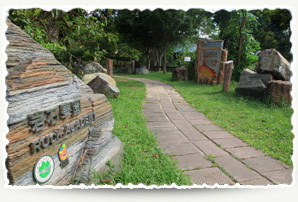 To sample the Hong Kong Global Geopark of China in the city centre, an exhibition featuring the Earth’s life history was opened to the public on October 3, 2011 at the lobby of the Bank of China Tower. The Prehistoric Story Room displays many valuable fossils and models, including an Armoured Fish model over 3 metres long, as well as ammonites and fish fossils discovered in Hong Kong. To sample the Hong Kong Global Geopark of China in the city centre, an exhibition featuring the Earth’s life history was opened to the public on October 3, 2011 at the lobby of the Bank of China Tower. The Prehistoric Story Room displays many valuable fossils and models, including an Armoured Fish model over 3 metres long, as well as ammonites and fish fossils discovered in Hong Kong.
A science popularisation programme called "Earth Members", which promotes earth science and geoconservation has also been launched. Through a series of Earth science exhibitions and other activities, the programme aims to help students enhance their Earth science knowledge and achieve a balanced development.
To arouse public interests in earth science and to enhance their understanding of geoconservation, two exhibitions about volcanoes and prehistoric life were held from December 2011 to February 2012 at the Science Museum and Hong Kong Museum of History.
To provide the public with a better understanding of different geosites, information panels were added at the Ma Shi Chau Nature Trail and those at the geo trails in Tung Ping Chau and High Island East Dam were updated. A "kid’s corner" was also added to the information boards at Ap Chau, Lai Chi Wo, Lai Chi Chong, Ma Shi Chau, High Island East Dam and Sharp Island to better serve the needs of younger visitors.
MANAGEMENT OF MARINE PARKS
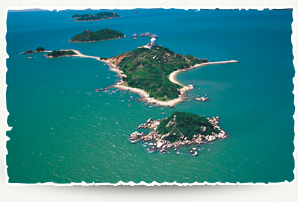 To cope with the rising number of visitors to our Marine Parks, we have adopted a series of measures including more patrols, assigning volunteers to disseminate codes for visitors, arrangement of guided activities and publication of educational materials. Law enforcement action was also stepped up to combat illegal activities. To cope with the rising number of visitors to our Marine Parks, we have adopted a series of measures including more patrols, assigning volunteers to disseminate codes for visitors, arrangement of guided activities and publication of educational materials. Law enforcement action was also stepped up to combat illegal activities.
NATURE CONSERVATION EDUCATION
Nature Appreciation Activities
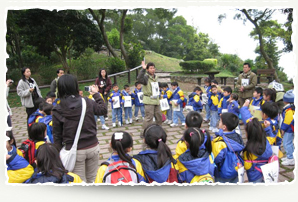 In 2011-12, the Department conducted a series of conservation activities for over 320,000 local students, teachers and nature lovers. The Department continued to carry out the Country Parks Education Programme "Nature in Touch" to strengthen the educational resources on nature conservation in country parks. This programme aimed at promoting a better understanding of country parks, biodiversity, flora conservation and geological characteristics in Hong Kong, thus enhancing public awareness of the importance in protecting the natural environment. The programme included a series of countryside learning activities for students and nature appreciation activities for the public. In 2011-12, the Department conducted a series of conservation activities for over 320,000 local students, teachers and nature lovers. The Department continued to carry out the Country Parks Education Programme "Nature in Touch" to strengthen the educational resources on nature conservation in country parks. This programme aimed at promoting a better understanding of country parks, biodiversity, flora conservation and geological characteristics in Hong Kong, thus enhancing public awareness of the importance in protecting the natural environment. The programme included a series of countryside learning activities for students and nature appreciation activities for the public.
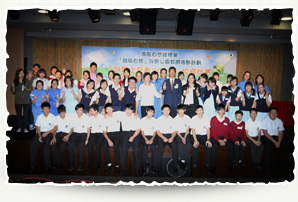 School education programme included Country Parks Orienteering, Kindergarten Visits, and school eco-tours. To encourage secondary students to gain insight of various conservation work in country parks, the "Country Parks Reporter Inter-school Competition" was held. The Department also organised outdoor field study activities to help teachers utilise the teaching tools in "Hong Kong Country Parks Education Kit for Secondary Schools" tailored for teachers.
School education programme included Country Parks Orienteering, Kindergarten Visits, and school eco-tours. To encourage secondary students to gain insight of various conservation work in country parks, the "Country Parks Reporter Inter-school Competition" was held. The Department also organised outdoor field study activities to help teachers utilise the teaching tools in "Hong Kong Country Parks Education Kit for Secondary Schools" tailored for teachers.
Public education programme comprised a wide variety of activities including guided tours at Nature Education Centres, Tree Walks fixed-point interpretation, "Nature in touch" workshops and themed exhibition and competitions to promote nature conservation. "CAS Hiking Safety Promotion Day", "Great Outdoors Hong Kong!" and "Hiking and Planting Day" activities were held to introduce to the public the fun of hiking and the associated safety knowledge.
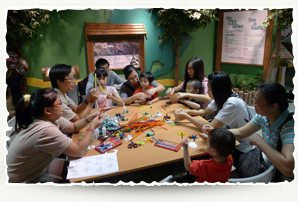 Under the Country Park Volunteer Scheme, some 540 volunteers had completed basic volunteer training during the year and these trained volunteers served 27,832 man hours in the country parks conservation and education activities including publicity events, roving exhibitions, fixed-point interpretation, hiking route patrols, facilities maintenance and vegetation management.
Under the Country Park Volunteer Scheme, some 540 volunteers had completed basic volunteer training during the year and these trained volunteers served 27,832 man hours in the country parks conservation and education activities including publicity events, roving exhibitions, fixed-point interpretation, hiking route patrols, facilities maintenance and vegetation management.
In addition, the Department introduced a new mobile application in 2011, "Hong Kong Geopark", to showcase the unique geological features and landforms of the Hong Kong Global Geopark of China by means of audio, video and text. The application introduces geotour routes and provides tips to enjoy the breathtaking views of the geological features and landforms of the Geopark. The "Hong Kong Geopark" mobile application was awarded one of the "Top 10 My Favorite HK Apps" in 2011.
Marine Conservation Education Programme
The Department organised a variety of marine conservation education activities targeting various sectors of the community. During the year, 144 public eco-tours, 7 public seminars, 4 beach clean-up activities, 82 school lectures, 54 exhibitions and 24 other kinds of educational activities were held, benefiting over 46,160 participants.
In 2010, the Department launched a pilot scheme of fisheries eco-tourism in Sai Kung and the northeastern waters of Hong Kong in collaboration with local fishermen and eco-tourism organsations with an aim to introduce the culture and practices of fisherman communities as well as the ecological and geological features of Hong Kong to the public through marine-based guided tours. 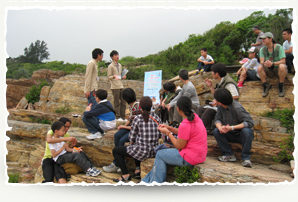 It is hoped that the fishermen can gain the experience and skills needed to run the business in a commercially sustainable manner in the future. The pilot scheme was extended to Hong Kong southern waters in March 2011 to allow more fishermen to participate in the scheme, better equipping them to switch to sustainable eco-tourism activities. During the year, a total of 154 school tours and 4 teacher workshops were held with over 5,100 students and teachers participating. Over 230 fishermen have been trained in this scheme. The operation of commercial tours also commenced and a total of 36 commercial tours with 1,125 participants were conducted. It is hoped that the fishermen can gain the experience and skills needed to run the business in a commercially sustainable manner in the future. The pilot scheme was extended to Hong Kong southern waters in March 2011 to allow more fishermen to participate in the scheme, better equipping them to switch to sustainable eco-tourism activities. During the year, a total of 154 school tours and 4 teacher workshops were held with over 5,100 students and teachers participating. Over 230 fishermen have been trained in this scheme. The operation of commercial tours also commenced and a total of 36 commercial tours with 1,125 participants were conducted.
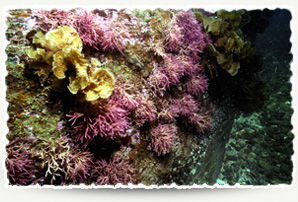 To enhance public understanding and interest in coral ecology and promote local underwater sites for coral appreciation, "Our Coral Underwater Photo Contest" was organised in 2011 with over 160 entries. To enhance public understanding and interest in coral ecology and promote local underwater sites for coral appreciation, "Our Coral Underwater Photo Contest" was organised in 2011 with over 160 entries.
In collaboration with the Ocean Park Conservation Foundation Hong Kong, the Department organised 24 dolphin field trips for secondary school teachers and students in 2011-12. The field trips provided opportunities for students to watch Chinese white dolphins and to learn more about marine conservation.
LAW ENFORCEMENT
Park wardens patrol country parks and special areas on a regular basis to provide visitor services and to enforce the Country Parks Ordinance and related legislation. In 2011-12, 835 offenders were prosecuted or given a fixed penalty notice. Among these, a total of 309 offenders were given a fixed penalty notice for littering or spitting. Statistics are at Appendix 14. Park wardens and nature wardens also conducted frequent special operations in the country parks, such as searching for illegal animal traps, visiting villages for the promotion of fire prevention, enforcing prohibition of feeding wild animals and assisting the Police in search-and-rescue exercises. Regular joint operations with the Police were undertaken to combat crimes, such as illegal felling of Buddhist Pines and Incense Trees.
In our marine parks and reserve, wardens patrol on a daily basis, watching out for any illegal fishing activities. Close liaison is also maintained with the Marine Police and the Fisheries Authority of Shenzhen to combat illegal fishing by Mainland fishermen in marine parks. Wardens give advice or warnings to visitors and institute prosecutions when necessary. In 2011-12, 48 prosecutions were instituted against illegal fishing activities in marine parks.
MARINE CONSERVATION
Reef Check
The Department coordinated the annual Reef Check in collaboration with the Reef Check Foundation. During the year, 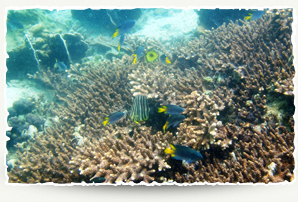 33 coral sites were surveyed with the assistance of over 500 volunteer divers. Twenty-three of these coral sites recorded high coral cover (i.e. more than 50%) and the growth of corals at all sites was stable. Results of the Reef Check were publicised to enhance public awareness of the current status of our marine environment and to seek the public's cooperation in protecting our valuable marine resources. The findings also provided the Department with important information on the health status of corals so that appropriate action could be taken to protect them. In 2011, the Department launched a new mobile application "Hong Kong Reef Check". Users can browse the coral coverage of the 33 selected sites, the distribution and pictures of indicator species including reef-building corals, fish and other invertebrates. 33 coral sites were surveyed with the assistance of over 500 volunteer divers. Twenty-three of these coral sites recorded high coral cover (i.e. more than 50%) and the growth of corals at all sites was stable. Results of the Reef Check were publicised to enhance public awareness of the current status of our marine environment and to seek the public's cooperation in protecting our valuable marine resources. The findings also provided the Department with important information on the health status of corals so that appropriate action could be taken to protect them. In 2011, the Department launched a new mobile application "Hong Kong Reef Check". Users can browse the coral coverage of the 33 selected sites, the distribution and pictures of indicator species including reef-building corals, fish and other invertebrates.
Conservation of Corals
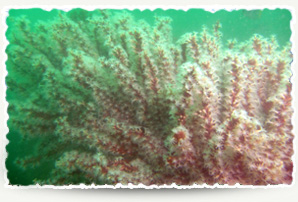 Specially-designed marker buoys were installed at Ung Kong Wan, Sharp Island and Port Island for better protection of corals from anchoring damage. Regular sea patrols and underwater ecological surveys were also conducted to monitor the effectiveness of the coral marker buoys in these areas. The results to date are encouraging. There has been an overall increase in live coral cover in the marker buoy area. Damaged corals have shown signs of recovery. Specially-designed marker buoys were installed at Ung Kong Wan, Sharp Island and Port Island for better protection of corals from anchoring damage. Regular sea patrols and underwater ecological surveys were also conducted to monitor the effectiveness of the coral marker buoys in these areas. The results to date are encouraging. There has been an overall increase in live coral cover in the marker buoy area. Damaged corals have shown signs of recovery.
The Department commissioned The Chinese University of Hong Kong to undertake a territory-wide study on octocorals and black corals. The final report of the study was completed in 2011. A record of 67 species of octocorals (29 species of soft corals and 38 species of gorgonians) and 6 species of black corals were found in Hong Kong waters. The study findings provided useful information for the conservation and management of the octocorals and black corals.
Conservation of Marine Mammals
There are at least 2,500 dolphins living in the Pearl River Estuary including about 1,300-1,500 dolphins living in the eastern part of the Pearl River Estuary and Hong Kong waters.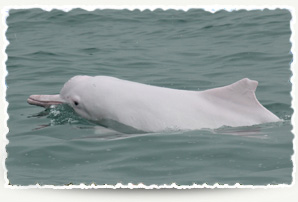 About 200 dolphins of this population live in the western waters of Hong Kong around Lantau Island, Tuen Mun, Sha Chau and Lung Kwu Chau. The Department has been implementing a Conservation Programme for the Chinese white dolphin since 2000. Tasks include habitat protection and management, long-term monitoring of the dolphin population, investigation of dolphin stranding, promotion of public awareness of dolphin conservation, and liaison with the Guangdong authorities to exchange information on the conservation of the species. Variations and trends in abundance of dolphins in Hong Kong waters during recent years are closely monitored. About 200 dolphins of this population live in the western waters of Hong Kong around Lantau Island, Tuen Mun, Sha Chau and Lung Kwu Chau. The Department has been implementing a Conservation Programme for the Chinese white dolphin since 2000. Tasks include habitat protection and management, long-term monitoring of the dolphin population, investigation of dolphin stranding, promotion of public awareness of dolphin conservation, and liaison with the Guangdong authorities to exchange information on the conservation of the species. Variations and trends in abundance of dolphins in Hong Kong waters during recent years are closely monitored.
Every reported dolphin stranding in Hong Kong was investigated by the Department in collaboration with the Ocean Park Conservation Foundation. Tissue samples from the carcasses were collected for further studies. The Department continued to hold exhibitions and seminars as well as to distribute posters and leaflets to promote conservation awareness, and publicise the code of conduct on dolphin watching and the dolphin stranding hotline. Through these efforts, the public gradually deepened their understanding of marine mammals.
Underwater Ecological Surveys
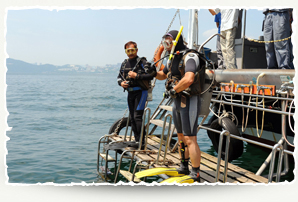 The Department formed a diving team for underwater ecological survey in 2011 with staff who were experienced in scuba diving and underwater ecological survey. The diving team will undertake thematic projects such as the long-term monitoring programmes for coral, reef fish and artificial reefs, and focused studies on the health of corals and the algae diversity. The Department formed a diving team for underwater ecological survey in 2011 with staff who were experienced in scuba diving and underwater ecological survey. The diving team will undertake thematic projects such as the long-term monitoring programmes for coral, reef fish and artificial reefs, and focused studies on the health of corals and the algae diversity.
ENVIRONMENTAL IMPACT ASSESSMENT STUDIES
The Department regularly provides comments and advice on development proposals and projects as well as Environmental Impact Assessment studies to ensure that potential impacts of development projects on the marine environment and ecology would be adequately addressed, evaluated and minimised through effective mitigation.
|

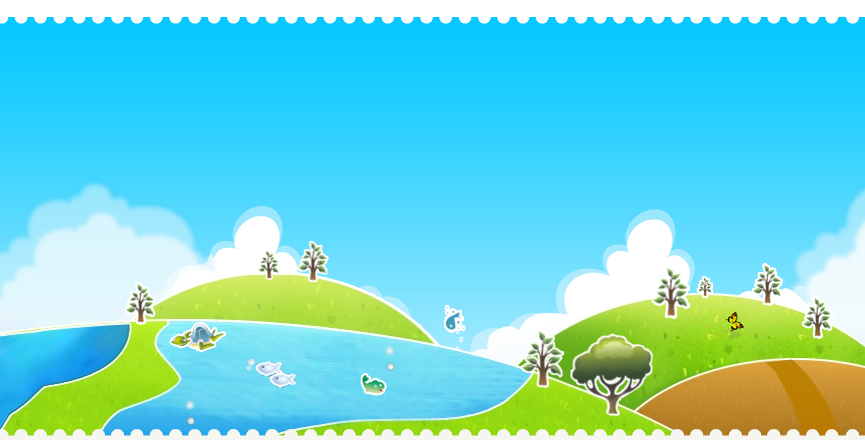








 To conserve the countryside, by March 2012, 44,239 hectares (about 40 % of Hong Kong's total land area) had been designated as country parks and special areas. The Department manages all 24 country parks and 22 special areas for conservation, recreation, education and tourism. Hiking trails, mountain bike trails, nature trails, barbecue and picnic sites, camp sites and visitor centres are provided in the country parks, drawing some 13.3 million visitors in 2011-12.
To conserve the countryside, by March 2012, 44,239 hectares (about 40 % of Hong Kong's total land area) had been designated as country parks and special areas. The Department manages all 24 country parks and 22 special areas for conservation, recreation, education and tourism. Hiking trails, mountain bike trails, nature trails, barbecue and picnic sites, camp sites and visitor centres are provided in the country parks, drawing some 13.3 million visitors in 2011-12.
 The Department manages four marine parks and one marine reserve for conservation, recreation, education and scientific studies, covering 2,430 hectares. They comprise scenic coastal areas, seascapes and important marine habitats with an abundance of important marine fauna and flora, providing ideal opportunities for diving, snorkelling, canoeing and underwater photography. Some 211,400 visitors to marine parks were recorded in 2011-12.
The Department manages four marine parks and one marine reserve for conservation, recreation, education and scientific studies, covering 2,430 hectares. They comprise scenic coastal areas, seascapes and important marine habitats with an abundance of important marine fauna and flora, providing ideal opportunities for diving, snorkelling, canoeing and underwater photography. Some 211,400 visitors to marine parks were recorded in 2011-12.
 the Department continued to produce and plant seedlings of native tree species. Major native species planted included Castanopsis (Castanopsis fissa), Chinese Hackberry (Celtis sinensis), Gordonia (Gordonia axillaris), Sweet Gum (Liquidambar formosana), Zhejiang Machilus (Machilus chekiangensis), Many-nerved Machilus (Machilus pauhoi) and Chinese Gugertree (Schima superba). Among all seedlings planted, 70% were native species.
the Department continued to produce and plant seedlings of native tree species. Major native species planted included Castanopsis (Castanopsis fissa), Chinese Hackberry (Celtis sinensis), Gordonia (Gordonia axillaris), Sweet Gum (Liquidambar formosana), Zhejiang Machilus (Machilus chekiangensis), Many-nerved Machilus (Machilus pauhoi) and Chinese Gugertree (Schima superba). Among all seedlings planted, 70% were native species.
 (i) To improve the ecological habitat of the plantation areas;
(i) To improve the ecological habitat of the plantation areas;  To cope with the increasing popularity of mountain biking activities in country parks, two new mountain bike trails, i.e. the Tai Lam Mountain Bike Practice Loop and the Tin Fu Tsai North Section Mountain Bike Trail, were built and opened to the public during the year. The Tai Lam Mountain Bike Practice Loop is located near Twisk Management Centre in Tai Lam Country Park. It consists of a 200-metre loop designed for beginners and a 200-metre section for mountain bikers with intermediate skill level. The Tin Fu Tsai North Section Mountain Bike Trail, also located in Tai Lam Country Park, is 2.1 km long, forming a loop near the Tin Fu Tsai Fire Lookout. About two-third of this trail is made of natural soil surface and the rest is forest track with concrete surface.
To cope with the increasing popularity of mountain biking activities in country parks, two new mountain bike trails, i.e. the Tai Lam Mountain Bike Practice Loop and the Tin Fu Tsai North Section Mountain Bike Trail, were built and opened to the public during the year. The Tai Lam Mountain Bike Practice Loop is located near Twisk Management Centre in Tai Lam Country Park. It consists of a 200-metre loop designed for beginners and a 200-metre section for mountain bikers with intermediate skill level. The Tin Fu Tsai North Section Mountain Bike Trail, also located in Tai Lam Country Park, is 2.1 km long, forming a loop near the Tin Fu Tsai Fire Lookout. About two-third of this trail is made of natural soil surface and the rest is forest track with concrete surface.
 The trail is suitable for cyclists with a certain amount of mountain biking skills. A picnic site near the trailhead of Tin Fu Tsai North Section Mountain Bike Trail was also converted to a mountain bike training ground, which provides a number of features for mountain bikers to develop their skills. Both new trails are designed and built in accordance with the principles for sustainable trail promoted by the International Mountain Bicycling Association of USA. Furthermore, an event "Share the Trail, Share the Fun" was jointly held by the Department and Hong Kong Cycling Association in Tai Lam Country Park on December 4, 2011 to promote mountain biking safety and the share use of mountain bike trails in country parks.
The trail is suitable for cyclists with a certain amount of mountain biking skills. A picnic site near the trailhead of Tin Fu Tsai North Section Mountain Bike Trail was also converted to a mountain bike training ground, which provides a number of features for mountain bikers to develop their skills. Both new trails are designed and built in accordance with the principles for sustainable trail promoted by the International Mountain Bicycling Association of USA. Furthermore, an event "Share the Trail, Share the Fun" was jointly held by the Department and Hong Kong Cycling Association in Tai Lam Country Park on December 4, 2011 to promote mountain biking safety and the share use of mountain bike trails in country parks. A geopark is a unique natural area with special geological significance, as well as natural and cultural landscapes, serving the objectives of conservation, education and sustainable development. Hong Kong Geopark was opened in 2009 and acquired global status in 2011 to protect Hong Kong’s rich geological resources and their high research, tourism, educational and scenic value.
A geopark is a unique natural area with special geological significance, as well as natural and cultural landscapes, serving the objectives of conservation, education and sustainable development. Hong Kong Geopark was opened in 2009 and acquired global status in 2011 to protect Hong Kong’s rich geological resources and their high research, tourism, educational and scenic value.
 To sample the Hong Kong Global Geopark of China in the city centre, an exhibition featuring the Earth’s life history was opened to the public on October 3, 2011 at the lobby of the Bank of China Tower. The Prehistoric Story Room displays many valuable fossils and models, including an Armoured Fish model over 3 metres long, as well as ammonites and fish fossils discovered in Hong Kong.
To sample the Hong Kong Global Geopark of China in the city centre, an exhibition featuring the Earth’s life history was opened to the public on October 3, 2011 at the lobby of the Bank of China Tower. The Prehistoric Story Room displays many valuable fossils and models, including an Armoured Fish model over 3 metres long, as well as ammonites and fish fossils discovered in Hong Kong.
 To cope with the rising number of visitors to our Marine Parks, we have adopted a series of measures including more patrols, assigning volunteers to disseminate codes for visitors, arrangement of guided activities and publication of educational materials. Law enforcement action was also stepped up to combat illegal activities.
To cope with the rising number of visitors to our Marine Parks, we have adopted a series of measures including more patrols, assigning volunteers to disseminate codes for visitors, arrangement of guided activities and publication of educational materials. Law enforcement action was also stepped up to combat illegal activities. In 2011-12, the Department conducted a series of conservation activities for over 320,000 local students, teachers and nature lovers. The Department continued to carry out the Country Parks Education Programme "Nature in Touch" to strengthen the educational resources on nature conservation in country parks. This programme aimed at promoting a better understanding of country parks, biodiversity, flora conservation and geological characteristics in Hong Kong, thus enhancing public awareness of the importance in protecting the natural environment. The programme included a series of countryside learning activities for students and nature appreciation activities for the public.
In 2011-12, the Department conducted a series of conservation activities for over 320,000 local students, teachers and nature lovers. The Department continued to carry out the Country Parks Education Programme "Nature in Touch" to strengthen the educational resources on nature conservation in country parks. This programme aimed at promoting a better understanding of country parks, biodiversity, flora conservation and geological characteristics in Hong Kong, thus enhancing public awareness of the importance in protecting the natural environment. The programme included a series of countryside learning activities for students and nature appreciation activities for the public.  School education programme included Country Parks Orienteering, Kindergarten Visits, and school eco-tours. To encourage secondary students to gain insight of various conservation work in country parks, the "Country Parks Reporter Inter-school Competition" was held. The Department also organised outdoor field study activities to help teachers utilise the teaching tools in "Hong Kong Country Parks Education Kit for Secondary Schools" tailored for teachers.
School education programme included Country Parks Orienteering, Kindergarten Visits, and school eco-tours. To encourage secondary students to gain insight of various conservation work in country parks, the "Country Parks Reporter Inter-school Competition" was held. The Department also organised outdoor field study activities to help teachers utilise the teaching tools in "Hong Kong Country Parks Education Kit for Secondary Schools" tailored for teachers. Under the Country Park Volunteer Scheme, some 540 volunteers had completed basic volunteer training during the year and these trained volunteers served 27,832 man hours in the country parks conservation and education activities including publicity events, roving exhibitions, fixed-point interpretation, hiking route patrols, facilities maintenance and vegetation management.
Under the Country Park Volunteer Scheme, some 540 volunteers had completed basic volunteer training during the year and these trained volunteers served 27,832 man hours in the country parks conservation and education activities including publicity events, roving exhibitions, fixed-point interpretation, hiking route patrols, facilities maintenance and vegetation management.  It is hoped that the fishermen can gain the experience and skills needed to run the business in a commercially sustainable manner in the future. The pilot scheme was extended to Hong Kong southern waters in March 2011 to allow more fishermen to participate in the scheme, better equipping them to switch to sustainable eco-tourism activities. During the year, a total of 154 school tours and 4 teacher workshops were held with over 5,100 students and teachers participating. Over 230 fishermen have been trained in this scheme. The operation of commercial tours also commenced and a total of 36 commercial tours with 1,125 participants were conducted.
It is hoped that the fishermen can gain the experience and skills needed to run the business in a commercially sustainable manner in the future. The pilot scheme was extended to Hong Kong southern waters in March 2011 to allow more fishermen to participate in the scheme, better equipping them to switch to sustainable eco-tourism activities. During the year, a total of 154 school tours and 4 teacher workshops were held with over 5,100 students and teachers participating. Over 230 fishermen have been trained in this scheme. The operation of commercial tours also commenced and a total of 36 commercial tours with 1,125 participants were conducted.
 To enhance public understanding and interest in coral ecology and promote local underwater sites for coral appreciation, "Our Coral Underwater Photo Contest" was organised in 2011 with over 160 entries.
To enhance public understanding and interest in coral ecology and promote local underwater sites for coral appreciation, "Our Coral Underwater Photo Contest" was organised in 2011 with over 160 entries.
 33 coral sites were surveyed with the assistance of over 500 volunteer divers. Twenty-three of these coral sites recorded high coral cover (i.e. more than 50%) and the growth of corals at all sites was stable. Results of the Reef Check were publicised to enhance public awareness of the current status of our marine environment and to seek the public's cooperation in protecting our valuable marine resources. The findings also provided the Department with important information on the health status of corals so that appropriate action could be taken to protect them. In 2011, the Department launched a new mobile application "Hong Kong Reef Check". Users can browse the coral coverage of the 33 selected sites, the distribution and pictures of indicator species including reef-building corals, fish and other invertebrates.
33 coral sites were surveyed with the assistance of over 500 volunteer divers. Twenty-three of these coral sites recorded high coral cover (i.e. more than 50%) and the growth of corals at all sites was stable. Results of the Reef Check were publicised to enhance public awareness of the current status of our marine environment and to seek the public's cooperation in protecting our valuable marine resources. The findings also provided the Department with important information on the health status of corals so that appropriate action could be taken to protect them. In 2011, the Department launched a new mobile application "Hong Kong Reef Check". Users can browse the coral coverage of the 33 selected sites, the distribution and pictures of indicator species including reef-building corals, fish and other invertebrates. Specially-designed marker buoys were installed at Ung Kong Wan, Sharp Island and Port Island for better protection of corals from anchoring damage. Regular sea patrols and underwater ecological surveys were also conducted to monitor the effectiveness of the coral marker buoys in these areas. The results to date are encouraging. There has been an overall increase in live coral cover in the marker buoy area. Damaged corals have shown signs of recovery.
Specially-designed marker buoys were installed at Ung Kong Wan, Sharp Island and Port Island for better protection of corals from anchoring damage. Regular sea patrols and underwater ecological surveys were also conducted to monitor the effectiveness of the coral marker buoys in these areas. The results to date are encouraging. There has been an overall increase in live coral cover in the marker buoy area. Damaged corals have shown signs of recovery. About 200 dolphins of this population live in the western waters of Hong Kong around Lantau Island, Tuen Mun, Sha Chau and Lung Kwu Chau. The Department has been implementing a Conservation Programme for the Chinese white dolphin since 2000. Tasks include habitat protection and management, long-term monitoring of the dolphin population, investigation of dolphin stranding, promotion of public awareness of dolphin conservation, and liaison with the Guangdong authorities to exchange information on the conservation of the species. Variations and trends in abundance of dolphins in Hong Kong waters during recent years are closely monitored.
About 200 dolphins of this population live in the western waters of Hong Kong around Lantau Island, Tuen Mun, Sha Chau and Lung Kwu Chau. The Department has been implementing a Conservation Programme for the Chinese white dolphin since 2000. Tasks include habitat protection and management, long-term monitoring of the dolphin population, investigation of dolphin stranding, promotion of public awareness of dolphin conservation, and liaison with the Guangdong authorities to exchange information on the conservation of the species. Variations and trends in abundance of dolphins in Hong Kong waters during recent years are closely monitored.
 The Department formed a diving team for underwater ecological survey in 2011 with staff who were experienced in scuba diving and underwater ecological survey. The diving team will undertake thematic projects such as the long-term monitoring programmes for coral, reef fish and artificial reefs, and focused studies on the health of corals and the algae diversity.
The Department formed a diving team for underwater ecological survey in 2011 with staff who were experienced in scuba diving and underwater ecological survey. The diving team will undertake thematic projects such as the long-term monitoring programmes for coral, reef fish and artificial reefs, and focused studies on the health of corals and the algae diversity.